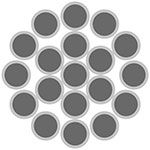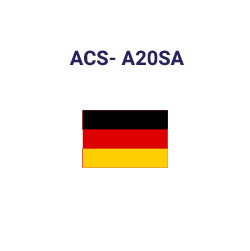| Serial Number |
Drawing | Code | Old code |
Area (mm²) |
No. of wires |
Dia Wire (mm) |
Dia Cond (mm) |
Mass per unit length (kg/km) |
Rated strength (kN) |
DC resistance Calculated using aluminium and steel (Ω/km) |
DC resistance Calculated using aluminium only (Ω/km) |
Final modulus of elasticity (N/mm²) |
Coefficient of linear expansion (1/K) |
Current carrying capacity |
| C0107AW024Q.DE | 1 | 24-A20SA | 25 | 24,2 | 7 | 2,10 | 6,30 | 161,5 | 32,49 | 3,536 4 | 4,699 5 | 159000 | 1,30E-05 | 65 |
| C0107AW034Q.DE | 1 | 34-A20SA | 35 | 34,4 | 7 | 2,50 | 7,50 | 229,0 | 46,04 | 2,495 3 | 3,316 0 | 159000 | 1,30E-05 | 80 |
| C0107AW050Q.DE | 1 | 49-A20SA | 50 | 49,5 | 7 | 3,00 | 9,00 | 329,7 | 66,30 | 1,732 8 | 2,302 8 | 159000 | 1,30E-05 | 115 |
| C0119AW066Q.DE | 2 | 66-A20SA | 70 | 65,8 | 19 | 2,10 | 10,5 | 441,0 | 88,18 | 1,310 2 | 1,741 2 | 159000 | 1,30E-05 | 135 |
| C0119AW093Q.DE | 2 | 93-A20SA | 95 | 93,3 | 19 | 2,50 | 12,5 | 624,9 | 124,98 | 0,924 5 | 1,228 6 | 159000 | 1,30E-05 | 170 |
| C0119AW117Q.DE | 2 | 117-A20SA | 120 | 117,0 | 19 | 2,80 | 14,0 | 783,9 | 156,77 | 0,737 0 | 0,9794 | 159000 | 1,30E-05 | 195 |
| C0137AW147Q.DE | 3 | 147-A20SA | 150 | 147,1 | 37 | 2,25 | 15,8 | 989,2 | 197,13 | 0,588 1 | 0,7815 | 159000 | 1,30E-05 | 225 |
| C0137AW182Q.DE | 3 | 182-A20SA | 185 | 181,6 | 37 | 2,50 | 17,5 | 1 221,2 | 243,38 | 0,476 4 | 0,6331 | 159000 | 1,30E-05 | 255 |
| C0161AW243Q.DE | 4 | 243-A20SA | 240 | 242,5 | 61 | 2,25 | 20,3 | 1 636,1 | 325,00 | 0,357 9 | 0,4756 | 157000 | 1,30E-05 | 310 |
| C0161AW299Q.DE | 4 | 299-A20SA | 300 | 299,4 | 61 | 2,50 | 22,5 | 2 019,8 | 401,24 | 0,289 9 | 0,3852 | 157 000 | 1,30E-05 | 355 |
NOTE 1: Direction of lay of external layer is right-hand (Z).
NOTE 2: Values of final modulus of elasticity and coefficient of linear expansion for the conductor sizes listed in the Table are used in Germany. Values for other conductor constructions may be calculated using the method given in IEC 61597.
NOTE 3: Guideline values of current carrying capacity are valid up to a frequency of 60 Hz, assuming a wind velocity of 0,6 m/s, the effect of solar radiation for Germany,
an initial ambient temperature of 35 °C and a conductor temperature of 80 °C. For special applications, when there is no air turbulence, the values should be reduced by 30 %.




